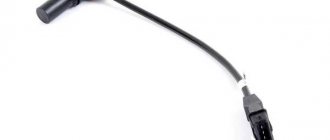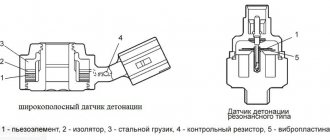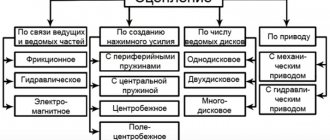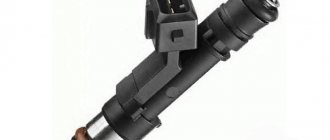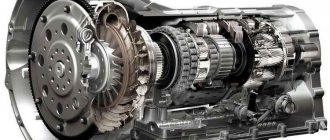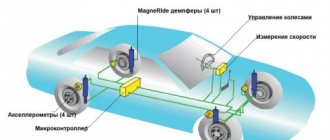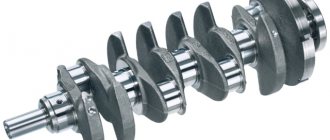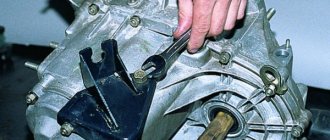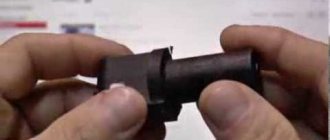View gallery
It is very difficult to imagine a modern car, be it a foreign car or a domestic VAZ, without an abundance of various electronic systems. All of them are divided into several categories according to their functionality. This could be a control system for the engine, gearbox, chassis and interior. Regarding the first point, one of the components of such a system is the crankshaft sensor. The VAZ-2110 and its subsequent models are equipped with it from the assembly line. Well, let's look at the features of this electronic device.
Lada 2110 ツɐʞdиҺツ (FORMER) › Logbook › All about the crankshaft sensor VAZ 2110, VAZ 2111 and VAZ 2112
So what kind of Sensor is this? Now let's try to figure it out.
The crankshaft position sensor (CPS) provides the ECU (electronic engine control unit) with information about the angular position of the crankshaft and the moment the pistons of the 1st and 4th cylinders pass TDC. If the sensor malfunctions, problems with engine operation occur. Let's consider the appointment, testing and replacement of DPKV.
What does the crankshaft sensor do?
DPKV synchronizes the phases of fuel injection and pulse supply to ignite the combustible mixture in the combustion chamber. In other words, based on its readings, the controller determines when and into which cylinder the fuel mixture should be supplied.
The sensor is of the inductive type and reacts to the passage of the teeth of the drive disk on the generator drive pulley near its core. The teeth are located on the disk at 6° intervals. To synchronize with TDC, two teeth out of 60 are cut off, forming a cavity. When a depression passes by the sensor, a so-called “reference” synchronization pulse is generated in it.
Signs of a faulty crankshaft sensor.
A completely faulty DPKV will not allow the engine to start. In other cases, sensor malfunctions can be identified by: - poor engine starting; — unstable operation of the motor; — reduction in engine power; — detonation with increasing load.
Where is the crankshaft sensor located?
It is installed on the oil pump cover.
Replacing the crankshaft position sensor VAZ 2110
To remove the crankshaft position sensor you will need a 10mm wrench. Procedure: Turn off the ignition and disconnect the sensor connector. Unscrew the sensor mounting bolt using a 10mm wrench. Remove the DPKV from the oil pump cover bracket.
Installation is carried out in reverse order. DPKV catalog number: 2112-3847010.
How to check the crankshaft position sensor with your own hands.
Checking the crankshaft position sensor comes down to checking the resistance of the windings. If the readings of the device (ohmmeter) differ from 550-570 Ohms, then the crankshaft sensor is faulty. If the crankshaft position sensor error does not disappear, then you should clean the sensor from dirt and check the integrity of the wire and the quality of the connections in the circuit. The crankshaft position sensor cannot be repaired.
Good luck to everyone on the roads!
Operating principle and location
It should be noted that malfunctions of the crankshaft sensor (controller here and further in the text) are rare, however, when going on a long trip, it is better to have a spare working sensor, if the DPKV fails, then further driving of the car most often turns out to be impossible. Let's move on to the principle of operation:
- The toothed pulley of the electric generator drive is made in the form of a disk with 58 teeth around its circumference, located every 6 degrees
- In order to generate a speed synchronization pulse for the injector, two teeth are specially missing on the pulley
Scheme of operation of a sensor with a pulley
- The car is equipped with either an all-metal pulley or a pulley with a damper (rubber insert)
- All-metal pulleys are practically not subject to wear during engine operation.
- You only need to ensure that there is no dirt or foreign particles between the teeth
- If the pulley has a damper, then you need to monitor the condition of the damper; damage to the damper will definitely lead to problems with engine operation
- When performing repair work, you must be careful not to subject the pulley to deformation; deformation can lead to interruptions in the operation of the motor.
- You can visually check the condition of the generator drive pulley by looking through the front right wheel arch
- In our case, the engine has an all-metal pulley
- If a malfunction occurs in the crankshaft position controller, or the drive pulley of the electric generator, as well as the timing drive, the computer may record an error, which will be reflected by the “CHECK ENGINE” light coming on.
- And enter the corresponding code “35” or “19” into the error buffer
The following symptoms characterize the occurrence of malfunctions of these elements:
- Unstable engine speed at idle
- There is a spontaneous decrease or increase in engine speed
- Complete stop of the engine and complete inability to start the engine
- Noticeable decrease in engine power
- The appearance of detonation under standard dynamic loads, as well as misfiring (motor trouble)
The question remains for the VAZ 2112 where the crankshaft sensor is located, the answer is - it is located on the oil pump cover.
Location of the crankshaft position controller
Description of the crankshaft sensor
So what is this controller and what is its purpose? Where can I find the device in order to replace it? What are the main signs of a device malfunction? We will give answers to these questions below.
Functions and purpose
On an engine with 8 or 16 valves, the DPKV is designed to perform not control options, but to implement phase synchronization for gasoline injection. Also, the crankshaft sensor on the VAZ 2110 transmits an impulse to ignite the air-fuel mixture in the combustion chambers of the power unit. Therefore, if the controller breaks down, this can lead to various vehicle systems not functioning coherently. This means that normal operation of the engine will be impossible.
VAZ 2112 crankshaft sensor
The VAZ 2110 crankshaft sensor itself is an inductive type device; this controller must respond to the passage of teeth on the master disk. This disk is mounted on the generator drive pulley, and the controller itself is installed next to it. There are 58 teeth on the pulley, between which there is a cavity the size of 2 teeth. This cavity allows synchronization with the top dead center of the engine pistons. The moment the depression passes the controller, a corresponding signal is sent to the engine control unit.
There are quite a few designs of devices of this type; the principle of their operation is based on a regulator such as the VAZ 2110 Hall sensor. In the latter case, the regulator also responds to a rotating shaft, but its operation is carried out as a result of the passage of a permanent magnet.
Where is?
If malfunctions are noticed in the operation of the engine, then before you begin to identify the breakdown and signs of malfunction, you need to find out where the regulator is located. Where is the crankshaft position sensor located on an 8- or 16-valve “ten”? If you open the hood, you will notice that the regulator can be found directly on the oil pump cover. As you can see, the location of the regulator is not particularly convenient. VAZ engineers thought through this point, thinking about the convenience of replacing the controller, so they equipped the DPKV with a long 80 cm wire.
Location of the DPKV under the hood of the car
Signs of trouble
If the controller located on the oil pump fails, the driver will not be able to start the engine. In the event of a breakdown, only replacing the regulator will solve the problem of the inability to start the motor. It should be noted that on 8- or 16-valve engines the problem of complete failure of the controller does not often occur; as practice shows, in most cases the problems accumulate.
So, what are the signs of a faulty DPKV:
- Reduced engine power when driving. When the driver presses hard on the gas, power loss may be felt. Note that in carburetor engines this can occur if the accelerator pump does not operate correctly.
- In some cases, engine detonation may occur, especially if it operates at high speeds. Sometimes this problem can be caused by the poor quality of the fuel used.
- It may be difficult to start the engine.
- Another sign of a malfunction that requires replacing the crankshaft sensor on the “ten” is increased gasoline consumption (the author of the video about replacing the crankshaft sensor on the domestic Lada is the IZO channel)))LENTA).
In general, failure of this controller can lead to unstable operation of the power unit. As for the reasons, they are usually due to manufacturing defects. In some cases, the regulator breaks due to contamination at the installation site.
Diagnostics
The diagnostic procedure for a device consists of checking the resistance parameter of its windings; an ohmmeter is used for this. If, as a result of diagnostics, the tester showed values other than 550-570 Ohms, this indicates a failure of the controller. To prevent damage to the sensor, its installation site must always be kept clean. In addition, it would be a good idea to check the integrity of the wiring; very often the quality of the connections plays an important role. As for repairs, the DPKV cannot be repaired; the regulator can only be replaced with a functional one.
Sorry, there are no surveys available at this time.
Methods for troubleshooting
If you find at least one of the above symptoms of a malfunction, then first of all pay attention to whether the device is dirty and whether there is any mechanical damage on it. To do this, you must first remove the device. This is not difficult to do and all we need is a 10mm wrench.
We carefully inspect for damage; if any are found, it is better to immediately go to the store for a new one.
You can check this device yourself; to do this, you just need to determine the resistance of the windings. The ohmmeter reading should be between 550-570 Ohms. If the readings are correct, then perhaps it's all in the wiring. Check all wires and connections one by one. Do not try to repair the crankshaft sensor on VAZ cars - it cannot be repaired.
Before installation, be sure to wipe the shrinkage area, it should be clean from dirt and dust. Next, install the shaft sensor and tighten the bolt. After connecting the wires, the work can be considered complete. As you can see, the whole procedure is quite simple. If you want to get more information, or do not understand where the shaft is located, then watch the video we offer.
Replacement Guide
How to replace the crankshaft position sensor on a VAZ 2110? To complete the task you will only need a 10mm wrench.
Step-by-step instructions for this process are presented below:
- First you need to turn off the ignition. Just in case, to prevent possible short circuits in the vehicle's on-board network, you can disconnect the negative terminal from the battery.
- Then open the hood and find the location of the controller. You need to disconnect the connector from the regulator.
- Using a 10mm wrench, you need to unscrew the bolt that secures the device. Remove the DPKV from its installation location on the oil pump cover, and then replace it with a new regulator. Before installation, you must be sure that problems in the operation of the power unit are not caused by poor quality wiring. Otherwise, the replacement will not give the necessary results. Clean the connector and installation location of the device from dust and dirt, this will avoid possible malfunctions in its operation in the future.
Where is?
To determine where the crankshaft position sensor is located on a VAZ car, it is enough to understand how it functions. It is not difficult. This device reads the teeth of the crankshaft pulley passing near its core, creating alternating current pulses, and then sends them to the electronic unit. This means that this shaft sensor can only be located near the generator pulley. It is secured with a bolt in a special bracket. A fairly long wire with a connector is connected to the sensor.
According to the standard, a VAZ 2112 with a 16-valve engine is equipped with an induction shaft position sensor, consisting of a special magnetized core and winding. He monitors the passage of sixty disc teeth past the core, which are placed at intervals of 6 degrees. The point is that 2 cloves in a row are missing, resulting in a small gap. When a depression passes past the device, a special impulse is created in it, transmitted through the ECU wire.
The VAZ control device calculates the crankshaft speed and sends special signals to the injectors. It is necessary to ensure that the gap between the magnetized core and the teeth is within 1±0.2 millimeters. If you need to check and possibly replace it due to a malfunction, it is easy to find - it is attached to the oil pump cover. Replacing and checking this device is simple and even a novice motorist can do it. And naturally, there is no point in going to the service station for this. This is a waste of money and time. Replacing this device yourself will take less time than replacing a wheel.
Malfunctions of the crankshaft sensor VAZ 2110 8 valves and their elimination
Thanks to innovative technologies, the VAZ 2110 is controlled by a computer. Multiple sensors record information and redirect it to the main center, which monitors the functioning of the systems.
If the regulator breaks down, the crankshaft sensor will stop the engine from functioning. The main function of this unit is to synchronize the processes of fuel supply and the operation of the ignition system. If a device breaks down, the synchronous functioning of these systems is disrupted. This leads to the fact that there will be no spark and no fuel will be supplied. The engine is capable of running for a certain period of time, but will soon stall.
How does the fuel system receive the signal from the sensor?
While the sensor is operating, the on-board computer (microcontroller inside the car) determines the specific position of the piston at a certain moment of its operation in each of the cylinders. To regulate operation using a sensor, the process is built according to the following plan:
- The crankshaft has a special gear in which 2 teeth are specially omitted.
- When the crankshaft moves, all the teeth pass next to the DPKV sensor, greatly distorting the state of its magnetic field.
- As a result, pulses are generated in the inductance coil of this device, which are sent to the on-board computer database. In this case, the missing 2 teeth are the starting or zero point, thanks to which the computer determines the initial position of the shaft.
- Next, the computer inside the car counts the number of pulses sent by the device and determines the position of the crankshaft in each period of time.
- After this, the return signal is sent by the computer to the sensor responsible for triggering the fuel injector, which already supplies fuel to the ignition system.
Thus, if the DPKV works correctly, the car will operate at the highest performance, while consuming a minimum of fuel.
Advice:
The wiring diagram for the VAZ-2110 will easily help you find out the cause of the sensor malfunction. It shows the location and combination of all elements of the car.
Why do you need a crankshaft sensor?
The sensor is the only device without which the engine will not be able to perform functions.
The sensor operates using the principle of electromagnetic induction. The necessary information will be read from the generator drive toothed pulley.
There are two types of faults with the crankshaft sensor:
- Damage to parts and windings of the device.
- Violation of the integrity of the wire and connections in the circuit.
The design of the crankshaft position sensor is not complicated. It breaks down extremely rarely. Errors or malfunctions of the crankshaft sensor in the VAZ 2110 8 valves are usually associated with manufacturing defects, mechanical damage and contamination. The first two points do not depend on the driver himself, but you can control the cleanliness under the hood yourself.
The engine compartment is exposed to various destructive factors. Dust flying from the roadway, stones, and temperature changes cause a number of problems in the area of oil leakage. If an engine oil leak is detected, it must be repaired without fail. Timely action is especially important at the location where the sensor is installed. You should ensure that the contacts are clean and protected. It is important to ensure that the insulated wires do not have exposed wires or damage. It is better to entrust the repair of the VAZ 2110 crankshaft sensor wiring to specialists.
Signs by which a malfunction can be identified
To check the operation of the crankshaft sensor, simple tools are enough: a regular screwdriver, a multimeter.
If the device has not completely failed, then the main symptoms of a malfunction of the VAZ 2110 8 valve crankshaft sensor are as follows:
- A warning light is on on the main panel, indicating that the engine should be checked.
- Craving decreases.
- Engine speed is unstable.
- It is impossible to start the engine.
- Shots from the intake and exhaust manifold are heard.
- Even at idle, the engine is unstable.
These signs will indicate that the sensor needs to be replaced.
If this sensor breaks down completely, the engine will stop immediately, as it will not fulfill its role:
- Send a signal to the ignition module.
- There will be no spark when the crankshaft is cranked by the starter.
- Gasoline will not flow into the ramp.
- The control unit will cease to function: it will no longer produce the signals necessary for the normal functioning of the engine.
The sensor surface may become clogged. It will need cleaning. However, if the cause is in the device itself, then it will need to be replaced.
Methods for checking the crankshaft sensor
In order to check the crankshaft sensor, it must be completely removed. First of all, you have to get to it. It is located near the generator pulley on the oil pump cover. The device should be removed. A 10 mm wrench is suitable for this.
Before you begin removing the device, special marks should be placed on it and the crankcase so that later the device can be easily put back in place or a new one can be placed correctly.
First, do a visual inspection. If the device has visible mechanical damage, scratches or dents are noticeable, then a complete replacement of the device is recommended. If there is no visible damage, then use a multimeter. There should be a gap of 0.6 - 1.5 mm between the sensor and the synchronization disk. If it is possible to check the node on a diagnostic scanner, a placement error will immediately appear. However, it may also be due to a broken wiring.
For the first test option, you will need an ohmmeter, which can be used to measure the resistance on the winding. The norm for the indicator is 550-750 Ohms. If compared to the norm there is a slight difference of up to 10%, then there is nothing to worry about. If there are serious deviations, the device must be replaced.
Checking the sensor is also possible using a voltmeter. For this option you will need a transformer and an inductance meter. Perhaps this method will be too complicated and expensive. Although it is considered quite effective.
First you need to calculate the inductance. If the device is working properly, then this value will be in the region of 200 - 4000 iH. The supply voltage will be at least 500 mV. Then you should take a megohmmeter and use it to measure the resistance, which should not be lower than 20 MΩ.
Failures of the crankshaft sensor on the VAZ 2110 are quite rare and are associated with the accumulation of dirt, manufacturing defects, and mechanical damage.
Replacing the crankshaft sensor on a VAZ 2110
Determining the malfunction of the crankshaft sensor in the VAZ 2110 8 valves and their elimination are interconnected with the replacement of the device. Easy to make. It is necessary to remove it and replace it with a new one.
To change the crankshaft sensor on a VAZ 2110, it is important to take into account a number of nuances:
- Spare parts should be purchased from specialized stores.
- When installing a new sensor, the original position must be respected. The corresponding labels will help you remember it. It is also necessary to observe the pinout of the VAZ 2110 crankshaft sensor.
- There should be a gap between the sensor and the timing disk.
- Bolts should be tightened to a torque not exceeding 8 - 12 nm.
If the VAZ 2110 8-valve crankshaft position sensor does not pass the tests and checks, you can judge that it is broken. When purchasing and installing a new attribute, it should be tested. You need to at least measure the resistance. If the check shows that it is in working order, then the sensor can be installed on the car. Do not forget that there must be space between the pulley teeth and the sensor. How correctly the control system will work depends on this factor.
A breakdown of the VAZ 2110 8-valve crankshaft sensor is reported when it has not passed the test.
Working principle of the crankshaft sensor
A signal is sent from the sensor installed opposite the crankshaft to the electronic control unit. But there is one peculiarity - there are 58 teeth on the pulley. And there is a small gap - it is equal to the distance between two teeth. It is through this gap that the sensor recognizes the position.
This is roughly what it looks like:
- When the crankshaft rotates, the sensor reads the number of teeth - exactly 58 pulses should be with an equal gap between adjacent ones.
- All this data is transmitted via the VAZ-2110 crankshaft sensor wire to the electronic control unit.
- Then the sensor falls on a gap without teeth on the pulley and the ECU monitors this condition.
- Using a gap without teeth, the number of engine revolutions is read.
- Due to the presence of teeth located at equal distances from each other, the electronic microcontroller unit understands the position of the crankshaft.
If you need to replace the device, be sure to install the same one as before. Otherwise, the operation of the motor may be disrupted or it may not be possible to start it at all.
Crankshaft sensor on a VAZ-2110: signs of malfunction
The crankshaft of a car is the most important organ that produces torque in a car.
Therefore, the accuracy of all related systems is important not only to maintain its activity, but also to ensure the movement of the machine. For this purpose, in modern cars produced by the VAZ automobile plant there is a system of various sensors that notify the car owner about the occurrence of emergency situations in the units of this complex mechanism. In the VAZ-2110 model, engine settings are controlled by a computer, the operation of which is based on sensor readings. However, if a malfunction occurs, only one of them is capable of blocking the operation of the engine - this is the crankshaft sensor (CPS - crankshaft position sensor). This unit is responsible for matching the operation of the fuel supply system with the ignition. If the DPKV fails, the synchronization between the mentioned systems is disrupted, after which the entire system stops working correctly:
- sparking may not occur;
- fuel supply slows down or disappears;
- problems arise in the operation of the power unit.
Any of the above problems causes the engine to stop.
How it all works
A modern car is equipped with a significant number of various sensors, the main task of which is to monitor the operation of mechanisms or systems.
Data from these sensors is transmitted to an electronic control unit, which, based on the information received, configures the operation of certain systems.
One of the most important of these control elements is the crankshaft position sensor (CPS, TDC sensor).
This sensor monitors the rotation speed of the engine crankshaft.
Based on its readings, the control unit adjusts the operation of the fuel system and ignition system.
To put it simply, based on the DCP readings, the control unit determines how much fuel to supply to the cylinders and when to do it, as well as at what moment to apply a spark.
Therefore, perhaps, this is the only sensor whose malfunction may prevent the power plant from starting, because a failure in its operation will lead to disruption of the fuel system.
Even if the power plant starts, its operation will be unstable, intermittent, etc. Therefore, this crankshaft sensor is very important and you need to monitor its performance.
Checking the DPKV for serviceability
To verify the suspicion of a breakdown of the crankshaft sensor, the two most likely cases of its malfunction are considered.
In both of these cases, you will need to dismantle the device using a ten-threaded wrench. Before the operation, marks are drawn on the crankcase and the sensor itself, which will later help to tighten the device to the initial angle of rotation. Also, the motorist should not forget to measure the clearance between the synchro disk and the sensor before dismantling, which cannot go beyond the size of 0.6-1.5 mm. If there are no mechanical damage such as scratches, dents, or damage to the material structure, the sensor is checked using other measuring instruments:
- checking with an ohmmeter. In this case, it is necessary to measure the resistance of the sensor winding. Since the standard value of this indicator, set by the manufacturer, ranges from 550 to 750 Ohms, going beyond the specified limits indicates the malfunction of this device, which is important for the correct operation of the car - which means it is faulty. It is worth noting here that the manufacturer still allows a slight discrepancy in resistance with the nameplate values, but in any case they must correspond to the data specified in the machine’s operating instructions;
- checking with a voltmeter, inductance meter and transformer. This method is more complicated, but more effective - the resistance is measured with the same ohmmeter, after which the inductance is checked (should be from 200 to 4000 millihenry), with a sensor winding voltage of 500 Volts. Next, you need to measure the resistance with a megger and make sure that it does not exceed 20 MOhm.
If the sensor still does not pass these tests, it must be replaced. During this procedure, it is necessary not to forget about the distance between it and the synchronization disk regulated by the manufacturer, as well as alignment with the marks on the crankcase that were made on the previous device. Before installing a new sensor, be sure to check it, since even if all installation procedures are followed correctly, it may not work properly.
A new DPKV is checked according to the same procedure as a supposedly faulty one, and based on the test results, the device can be installed instead of the previous one or rejected. When installing, the bolts are tightened with a torque of 8 to 12 Nm. However, in any case, before carrying out all the actions to replace a rather expensive and hard-to-reach component, you should definitely make sure that it is the one that has failed, because cars produced by our automotive industry can often bring unpleasant surprises.
Functionality check
Don't rush to conclusions. You shouldn’t blame DPKV for all the troubles. Sometimes it turns out that the cause of the problem is completely different. Therefore, first you should check whether your DC is working or not.
There are several ways to check.
- Multimeter. Your task is to measure the coil resistance on the induction sensor. If it is working properly, then the indicator will be from 500 to 700 Ohms.
Multifunctional multimeter
- Set the measurement limit on the multimeter to 200 millivolts, connect the probes to the output and pass a metal object around the core several times. If the sensor is working, it will be able to detect this metal and a voltage spike will appear on the display. If there are no surges, the DC must be replaced.
- An oscilloscope. This verification method gives the most objective and accurate result, equal to almost 100%! (MISSING)Connect the device to the engine and read data in different modes. The engine will need to be started at different speeds - from 800 and above, up to 6 thousand. Look at the lines appearing on the screen. If they are of different lengths, you should look for the reason for the malfunction. Sometimes simple cleaning of dirt, checking the pulley for damage and other measures helps.
Crankshaft sensor VAZ 2110
The crankshaft position sensor is an electromagnetic element whose functional purpose is to synchronize the fuel injectors and the ignition system in fuel injection.
Faulty operation of this element leads to unstable operation of the power unit, which leads to increased fuel consumption and also reduces the service life of the engine.
With prolonged use, like any complex structural element, the crankshaft position sensor of the power unit may begin to operate unstably. Typical malfunctions of this element are:
- The presence of an engine check mark on the dashboard, which indicates a malfunction of the engine;
- Reduced dynamics during acceleration or traction under engine load;
- A sharp change in engine speed with a stable position of the accelerator pedal;
- Problem starting the power unit;
- Unstable engine operation when cold or at idle speed;
- Engine detonation is observed and shots are heard from the exhaust manifold.
Important to remember! If one or more factors from the above list are present, it is necessary to urgently diagnose the crankshaft solenoid valve. Otherwise, neglecting the problem can lead to a sharp decrease in the engine's service life, which can lead to costly repairs in the near future.
A crankshaft sensor for a “ten” costs approximately 400-500 rubles on the Russian auto components market. It would be more rational to replace the faulty part in a timely manner rather than delay the repair procedure until the situation worsens.
Design and functions of DPKV
This vehicle unit allows you to adjust the fuel injection system of your vehicle. In addition, the DPKV is responsible for the synchronization of the functioning of each of the fuel injectors and the entire ignition system of the car. The crankshaft position sensor device has the following elements:
- Sample of a nylon frame;
- Steel magnetic cores;
- Winding kit for which thin copper wire is used;
- Wiring insulation (usually resin or enamel is used).
The main purpose of this position sensor is to create synchronized operation in the ignition system and when operating a set of fuel injectors. If this spare part malfunctions, unstable operation occurs during fuel supply. Additionally, your engine may suddenly stop running at full speed, causing wear on the valves and cylinders.
How to check the performance of the crankshaft sensor
Before replacing an electromagnetic sensor, it would be wise to check its functionality - a fairly popular reason is rotten wiring supplying current from the part itself. To check the serviceability of the crankshaft sensor, you need to dismantle the element, and then check the part with an ohmmeter.
It is necessary to measure the resistance of the sensor on its conductive winding by connecting an ohmmeter. According to the manufacturer's standards, the resistance of a functional sensor is between 550 and 750 Ohms. If the indicator deviations differ greatly from the factory parameters, then it is advisable to replace the indicator with a properly functioning element.
It is important to know! To be fair, it would not be out of place to note the high service life of this element. The crankshaft position sensor on the VAZ 2110 lasts quite a long time and fails as a result of the accumulation of dirt or small abrasive elements that interfere with stable current transmission.
In most cases, to restore the functionality of this element, it is enough to disassemble the sensor, clean the electromagnetic mechanism and clean the contact terminals from traces of corrosion.
How to replace the crankshaft sensor on a VAZ 2110: step-by-step instructions
The procedure for installing a crankshaft sensor on a VAZ 2110 does not present any particular difficulties - the maintenance algorithm consists of dismantling the old element and installing a new one. In this regard, to replace the element, no specialized equipment is required - the entire process is carried out with a pair of socket wrenches "10", and insulating tape and sealant will also not be superfluous.
To replace the electromagnetic crankshaft sensor you must:
- First of all, disconnect the battery to prevent the possibility of a short circuit, and also remove memory dumps from the sensors of the crankshaft, camshaft and engine ECU;
- Next, we find the sensor itself - the part is located on the oil pump cover, next to the electric generator pulleys;
- Then we disconnect all the wires leading to the mechanism and carefully dismantle the sensor itself using wrenches;
- It is advisable to clean the seats of the mechanism with a file from traces of corrosion, and the place where the indicator is attached - from traces of old sealant;
- Next, we diagnose the device, after which, if necessary, we sort out the mechanism or install a new element;
- When installing a new sensor, it is a good idea to take care of the insulation of the wiring and the tightness of the element itself.
When all procedures are completed, you must reconnect the battery and start the car engine. If the power unit is successfully ignited, as well as with a smooth idle, the procedure for replacing the crankshaft sensor can be considered successful. Do not skimp on the quality of the indicator itself - purchase only an original set of components. Installing a more budget-friendly analogue from China is more likely to harm the car - in this case, saving on spare parts is inappropriate.
